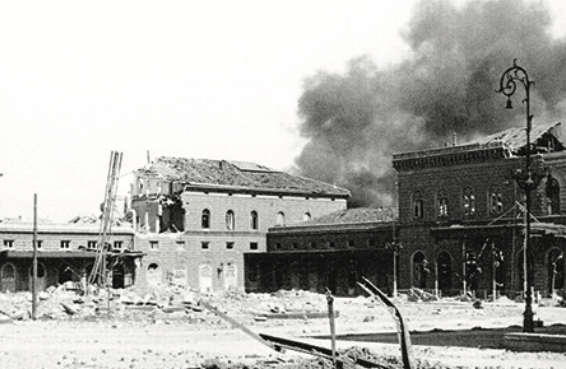Inaugurated in 1859, and expanded in the following years to accommodate the growing traffic, the Bologna Station immediately became a reference point for the city as well as Italy. The passage of trains from all over the country and from abroad (from 1871 even came through the famous Valigia delle Indie, a postal and passenger service between London and Bombay) attracted curious citizens, young and old, who enjoyed watching travellers, dreaming of leaving one day they too. Expanded over time, in 1934 it took on a look similar to what we know today, with the Piazzale Medaglie d'Oro, the bridge of the Galliera overpass and the construction of new squares. An increasingly important railway junction, it was not spared by the bombardments of the Second World War. All over Italy roads, ports, airports and railways, all infrastructure potentially useful to the German and Italian army, were attacked.
From July 1943, with the landing of the Allies in Sicily, and until the end of the conflict, even Bologna suffered numerous devastating air raids. The Station was considered a primary military target and was targeted by air strikes. The British Commands hoped, in this way, to block the passage of German troops from Brenner to Rome. To stop the convoys, on the night of July 15, 1943, the power supply centre of the railway network, the transformation and sorting station located in the Santa Viola district, was hit. The power plant was hit by 19 tons of bombs as well as workshops, freight yards, railway yards. Air raids continued. Ten days later, on July 24, 51 Twelfth Air Force bombers from the United States of America dropped 136 tons of bombs against the railroad and the city, destroying buildings and lives. Not even the armistice of September 8th stopped the American army because, occupied by German troops, the Station continued to represent a nerve centre. So, on September 25th, the most devastating launch took place: 210 tons of bombs released such fog dust that, by obscuring the bombers' view, in addition to the railroad the city was destroyed. The attack of October 5 brought definitively to the ground the Central Station, which was to be hit again in 1944, with further raids against the railway stations of San Donato and San Ruffillo. At the end of the war, Bologna would be the centre of northern Italy with the highest number of victims and the most serious damage done to its artistic and industrial heritage. The reconstruction of the city would give the Station its original splendour, but, unfortunately, on the tragic morning of August 2, 1980, at 10:25 a.m., it was hit again by a bomb killing 85 innocent people and destroying part of the buildings.

Today Bologna Centrale's hundreds of high-speed trains carry millions of passengers, but its clock, which in the nineteenth century stood on a tower, is still stopped at 10:25. And so, by looking up, we can remember a time that must never repeat itself.




.png)